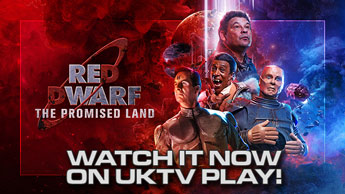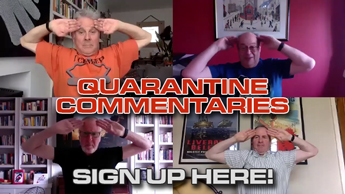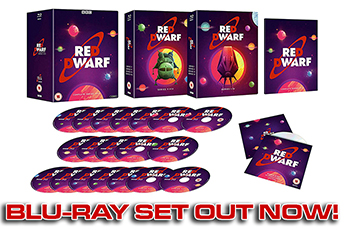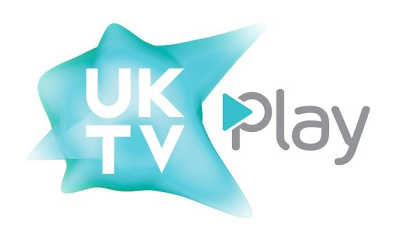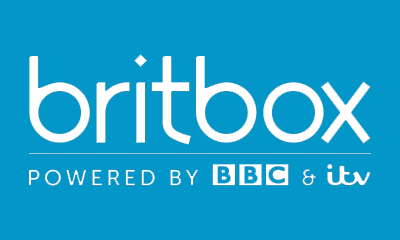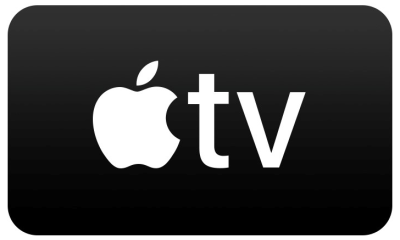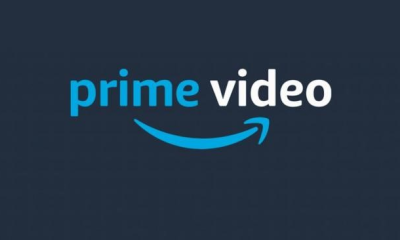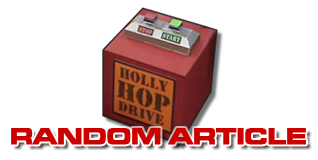 |
Snap Happy Mr Flibble pulls out a wide-angle lens and gets the big picture from RD photographer Mike Vaughan. |

Andrew Ellard
Mr Flibble had recently had a photo shoot done and was checking over the shots - does he look better with an attitude, or playing it cute? Mike, thankfully, had no opinion - but did tell Andrew how he BEGAN in photography.
I left school and went to work in a photographic shop. I didn't learn much about photography there, you were just a salesman. From there I got the chance to go to Pinewood Studios stills department and assisted there - which I loved. The Carry On films and all that, the early days in the 60s, Bond - I always remember Thunderball - and Chitty Chitty Bang Bang. It was brilliant, just to be part of it. [I was] just doing continuity stills at the beginning, not publicity stuff. Then a chance came up at London Weekend Television and I went there... for 18 years.
My boss knew I didn't like football, and yet I did 14 cup finals - never knew who was playing half the time! (Laughs) The World Cup, the Olympics... I could yawn at the Olympics, but it was his way of getting me out and about. But it was a great time, a happy time for television.
Then I went to Hollywood with The South Bank Show, then got a phone call while I was there saying I was [being made] redundant. I came back and went back to Pinewood, rented an office, and I've been there for 15 years.
What have you worked on?
Inspector Morse was one of the things I started doing when I was freelance. I worked on Poirot when I was at LWT, and Upstairs Downstairs. Blind Date was always a lovely thing to work on - we used to go on the dates, doing the photography! It was like going away with your mates, it wasn't working, really. (Laughs) Bad Girls, Footballers' Wives, Thomas the Tank Engine - it's been a great thing to do.
Mr Flibble selected one from the 'tutu set' and moved on to the poolside pictures. How did you get involved with RED DWARF?
I don't know! I didn't know anything about Red Dwarf, I didn't see the programme before I came on it [for Series IV]. They were shooting it, and I just came to realise that these characters were just absolutely brilliant. I just fell in love with the whole thing. I just thought, 'I am desperate to get the next series, I want to be on it.' I don't know who got me on it, it was just word of mouth: 'He's a little bloke who won't be obtrusive on set.' (Laughs)

When I first started on Dwarf, the cockpit was [built] quite high, so the cameras were at the very top of their ped[estal]s with the cameramen looking up to their viewfinders. Which was fine for them, and if I was six foot six, it'd be fine for me - but being five foot six it was a bit awkward! Tony Keen, a lovely cameraman, realised I was struggling - even if you have a box, because the cameras moved you would get knocked off, or people would tell you you can't be there. So Tony pulled me over and lifted me up! I was stood on the ped of his camera, shooting into the cockpit! (Laughs)
What is the process on-set?

With Red Dwarf the sets - the way Peter [Morgan] lit it, it was beautiful. Sometimes if you looked at the sets and then looked at the monitors, you'd think 'they're getting away with murder! That's not the same thing I'm looking it.' Low light levels - for me - but normal for them. You think, 'I'm going to struggle here.' But faster film became available at the time.
I preferred to shoot on transparency because I thought it worked better for that production, to give me something near to what they're seeing on TV. I worked with the lab at Pinewood a lot, and you'd struggle now and again because, if you don't have that light, you are pushing the film to the limit and you can get a lot of grain.
Of course, when there's an audience it usually means more light on the set...
Without the audience it was more of struggle, technically, but I have to say that Peter Morgan was very good to me. He would see that I'd need a studio floor lamp for a set-up somewhere and just whip one in. Having dropped the levels of light for filming, he'd push the levels back up for me, just to get the shots. He was very good to work with.
Mr Flibble was a little concerned to find he'd been photographed in a pink ballgown - something he has no memory of. How do you find shooting on LOCATION? Places like the exotic Sunbury Pumphouse...

With all those dead pigeons! (Laughs) That was a challenge. Farnborough, that was another challenge. That was where they tested Concorde engines, the huge wind tunnel [used in Tikka to Ride]. You look around studios and think, 'These are not the cleanest places in the world' - well the [locations] are even worse! (Laughs)
The Dallas stuff was so well done. Frightening, really. The motorcade came down and you just thought, 'This was a part of history.' You're there with a long lens, just focussed on the motorcade coming down - and you think there was a bloke there doing that. I know it was recreated for TV, but it was so real.
When we were shooting down near Canary Wharf, in the old Telegraph building, one time, there was this huge hole in the roof. And this old caretaker guy told us that when the IRA tried to blow up Canary Wharf, they blew the truck up and the engine came through the roof! I thought, 'You'd think they'd fix that...!' Danny did his dancing in there (for Back In The Red) and I thought that was so good. Danny's skills shine through - he does look very good.
I always get [on location] early, because I like to say hello to people and let them know what I'm doing. And once I know what they're doing (via the call sheet), I can work out what I want to do and, with the publicist, work out what pictures we need from that day.

I get as much as I can during the day, with some set-up [pictures] if that's possible. Location days are, I always think, good days for photography. There are always [spare] moments, because they're not shooting all the time. Rehearsals are very good, but they might not be fully dressed for rehearsals - especially Kryten. With studio, it's a bit more awkward.
So I would pick off each character now and again, over the weeks, so I wouldn't be pushing all four or five of them at the same time. Then I try to get stuff during the recording, which is always a challenge. We use a camera in a box, a 'blimp box', so you can get away with shooting stuff without people hearing it. Sound are happy, the artists are reasonably happy - on Red Dwarf it was easy, because if you hid by the camera you were okay. But if you stood between the two cameras then you were suddenly in an [actors] eye-line - and I know so many guys who got caught out on that.
It's not so easy when they're recording in front of an audience, because you're a distraction. The audience see you and think, 'Where's he come from?' But it always worked well, because [the producers] were always keen on photography, on publicity.
What are your strengths do you think?

Getting on with the cast. I was proud to think that they liked me, liked what I was doing, and were aware that I needed to be there talking those photos. Other guys who shot it, I'm sure, will say the same thing, but I was lucky to get on with them.
Danny just loves it - whenever you pull a camera out, he poses! Doesn't even have to be a camera! It could be the CCTV and Danny'll be there doing his thing. (Laughs) Chris is slightly more serious. Craig, as long as he had a gun in his hand, he was happy. (Laughs) You could feel for [Robert], because even in winter it gets warm in that studio. He did do so well. There were a few frayed tempers that I've heard about, but it was never in front of me.
What are your favourite episodes? (And please ignore Mr Flibble holding up the 'Quarantine' placard.)
Every one of them! I could watch them all millions of times. I prefer the ones with more effects and locations - there's more in it. One thing that always saddened me was that it's only a thirty-minute programme. There's so much crammed into it. I would realise that there's only ten minutes to go, and I just hated that. It's like seeing a good film, when you come out you want to go right back in.
I became a bit of a Dwarf fan - even bought the jacket! (Laughs) On Dwarf I creep between the cameras - and this has only happened at rehearsals - and I can get really into it, and suddenly notice that the cameras have all moved back. I'll be five feet in front of them and realise, 'I shouldn't be here'.

What have been four favourite jobs away from Red Dwarf?
I loved Father Ted. Everybody on that was so sweet - great scripts, great television. That really came together. Poirot was another one.
I once got a telephone call: 'Do you want to work on Bond? The World Is Not Enough'. 'I'd love to!' Shooting time was getting a bit serious and I was on third unit in the tank at Pinewood. I hadn't worked with any of them and I crept on set, and Robbie Coltrane was on it - and he shouted "Hey, my man!" across the set. I'd known Robbie since Cracker. Then he introduced me to Robert Carlyle, and then they said Pierce Brosnan was coming down.
Suddenly it all changed. They were doing action stuff, gunfire and things. Pierce was helecoptered in, and I did go and say hello. We just sat around, and then he said, "I'm not sure if I fancy lunch today." It was quite a warm day, and I said a pint of Guinness would go down well, and he said, "Where do you drink your Guinness? Do you fancy one?" So I told the first assistant I was going for a drink with Pierce Brosnan!
I left all my gear on the set and was whisked away, with Pierce driving. We went into the pub... and there wasn't a soul in there that I knew! Even the landlord and landlady had gone! I just thought 'nobody's going to believe it...'
Mr Flibble enjoyed talking to Mike Vaughan, and now that it's over... Mr Flibble is very cross.

